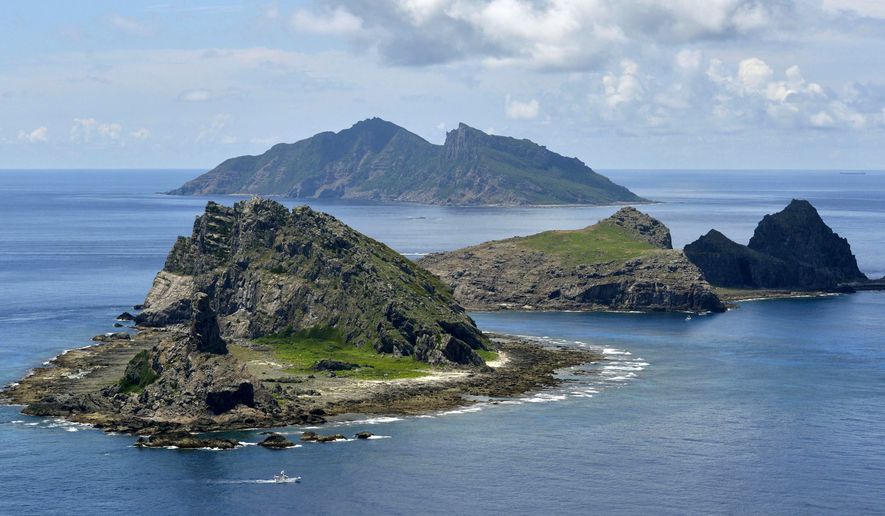Key political figures in the island democracy of Taiwan are embroiled in a war of words over an explosive issue: Who owns a tiny, uninhabitable island chain in the East China Sea?
The fight was ignited by former President Lee Teng-hui, who dropped a bombshell in Tokyo on July 23 by stating that these disputed isles, mostly known in the world as the Senkakus, belong to Japan.
Mr. Lee was Taiwan’s first democratically elected president, from 1996 to 2000. He received his college education in Japan when Taiwan was a Japanese colony, before 1945. He went on to get his doctorate in agriculture economy at Cornell University in New York.
The disputed isles are called by different names by the three main claimants. For Japan, which exercises administrative control, they are the Senkakus; for China, the name is Diaoyudao; in Taiwan, they are known as Diaoyutai.
Mr. Lee’s statements sparked a firestorm in Taiwan, where President Ma Ying-jeou wrote a searing rebuttal Monday. Mr. Ma accused Mr. Lee of making a perfidious statement on sovereignty. He also criticized Mr. Lee for his inconsistency on the issue, pointing out that when Mr. Lee was president, he was emphatic about the Diaoyutai belonging to Taiwan but now is reversing himself.
Mr. Lee’s camp refuted Mr. Ma’s accusation, asking Mr. Ma to read more history books on the issue and try not to seize upon the Diaoyutai controversy to draw the Taiwanese voters’ attention away from the Ma administration’s incompetence and unpopularity in the polls.
The two presidential candidates — Tsai Ing-wen of the opposition party DPP and Hung Hsiu-chu of the ruling KMT — issued statements criticizing Mr. Lee’s remarks. Ms. Tsai, a longtime friend and protege of Mr. Lee’s, used milder language in her rebuttal than Ms. Hung, who vehemently opposes Mr. Lee and calls him a traitor.
The sovereignty fight over these tiny isles is not simply a war of words, and the stakes are extremely high. China’s unrelenting and aggressive maritime and military challenge of late to Japan’s control over these islands is threatening to bring the world’s three largest economies — the United States, China and Japan — into a general war of unimaginable carnage.
While the U.S. government claims to be neutral in the sovereignty dispute, Washington is obligated by a mutual defense treaty with Tokyo to commit military force to defend any territories administered by Japan, including the Senkakus.
Yet the Senkakus dispute is equally fundamental to Taiwan, especially for the ruling KMT party, as it has always been an existential issue, directly linked to such weighty matters as the international legitimacy of the Republic of China (Taiwan), national identity as an island democracy and the future of Taiwanese polity.
In fact, it was Taiwan, not China, that started the Senkakus sovereignty controversy during the Nixon administration. Before 1970, neither China nor Taiwan had made any meaningful sovereign claims to the isles. Japanese sovereignty was generally accepted by the international community.
Since the end of World War II, the U.S. government occupied Japan and placed the Senkakus under American military administration but acknowledged Japanese ownership. The U.S. Navy used two of these isles, Kobi-sho and Sekibi-sho, as gunnery ranges and even paid the Japanese owner of Kobi-sho an annual rent of $11,000.
When the Nixon administration was contemplating abandoning the Republic of China as the legitimate government of China and returning the Senkakus to full Japanese administration, Chiang Kai-shek was infuriated and challenged the U.S. and Japan.
On July 20, 1970, for the first time, Taipei sent a diplomatic note to Tokyo challenging the claim that the Senkakus were part of the Ryukyu islands. Before Tokyo could reply, a Taiwanese national broke through the Japanese maritime patrol, landed on one of the Senkaku islands and painted “Long Live President Chiang [Kai-shek]!” on it, which prompted a surprised Tokyo to reaffirm its sovereign right to the Senkakus.
When the ROC-Japan dispute heated up, the Nixon administration was forced to make a public statement on the issue. In a characteristic Washington fashion, President Richard Nixon refused to take a side in the sovereignty fight but urged the Republic of China and Japan to calm down and set up a quasi-governmental Japan-ROC-South Korea “tripartite committee” to solve the dispute peacefully.
The tripartite committee, which first met in Seoul on Nov. 12, 1970, ended up with a Japanese proposal of a joint development plan of these islands, which infuriated China, not because Beijing cared much about the Senkakus up to that point, but because Taiwan, the Republic of China, was invited to take part as a legitimate government entity.
China made its first sovereign claim soon after the tripartite committee meeting. On Dec. 3, 1970, Xinhua News Agency blasted the committee and claimed for the first time that the Senkakus, or Diaoyudao, were part of China’s continental shelf, belonging to China. The Japanese joint development proposal was an insidious plot by “the Chiang Kai-shek bandit gang and the Park Jung Hi Clique, whose purpose was the plundering of the seabed and undersea oil resources of China and Korea,” said Xinhua, as quoted by a declassified 1971 CIA report on the Senkakus dispute.
In the following years, Nixon went to China, starting an irrevocable move of replacing Taipei with Beijing as the legitimate representative of “China,” a move that also made the Senkaku sovereign issue a powerful expression of Taiwan’s quest for international respect and relevance.
As a die-hard KMT follower, Mr. Ma, then a Harvard law student, was an activist in the Preserving the Diaoyutai movement in Boston via his involvement in a KMT-sponsored journal, The Boston Bulletin, and the Anti-Communist Patriotic Alliance — an existential passion that is still in vivid display in Mr. Ma today.
• Miles Yu’s column appears Fridays. He can be reached at mmilesyu@gmail.com and @Yu_miles.
• Miles Yu can be reached at yu123@washingtontimes.com.




Please read our comment policy before commenting.